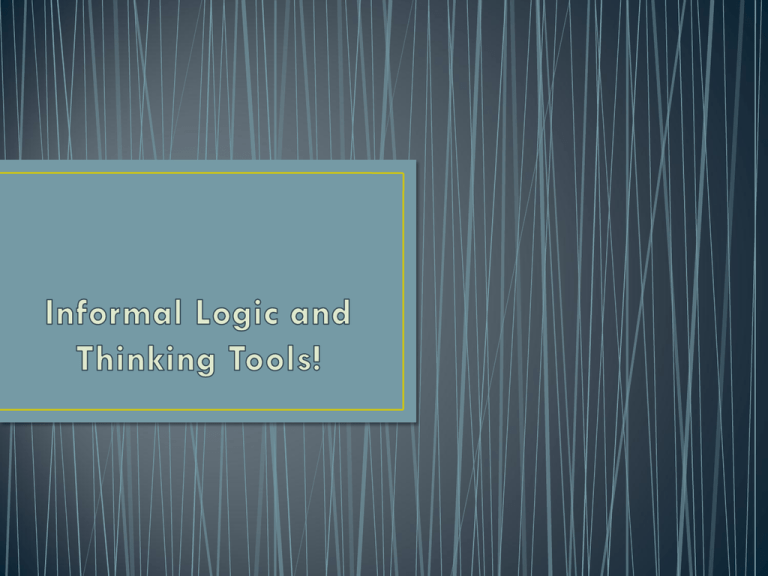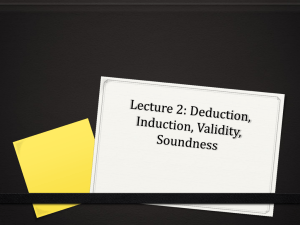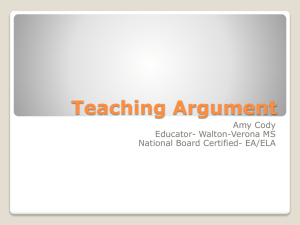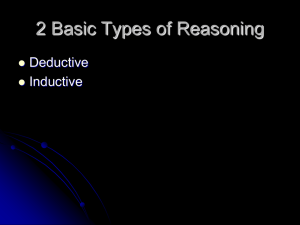
Burn the Witch!!!!
• The study of the nature of
arguments.
• Know known as “Critical
Thinking.”
• Developed by the Greek
Philosopher Aristotle.
• What is an argument?
• a group of statements that
attempt to establish a claim.
• Conclusion—the claim that an
argument is trying to
establish.
• Logic is the foundation of “deep thinking” or
Philosophy
• Learning to think logically will help you
become a better philosopher
• Becoming a better philosopher will make
philosophy more enjoyable
• You will stop believing whatever you hear and
start asking “why?” or “by what argument?”
• You will be able to better formulate your own
Arguments
• You will be able to spot fallacies
• Bell Ringer…
• Objective and Agenda:
Through notes, discussion,
and scenarios, students
will identify the
components of an
argument.
• QUIZ TOMORROW!
• What is Logic?
• What is an argument?
1. We prefer stories to statistics.
OR
Which do YOU prefer?
2. We seek to confirm, not question, our ideas.
We see what we want to see
But is this professional?
3. We rarely appreciate the role of chance and
coincidence.
Yes.
Could this be a coincidence?
4. We sometimes misperceive the world around us.
Is this a face on Mars!?
Or a problem with our focus?
5. We tend to oversimplify our thinking.
Is Hillary Orwellian?
Is Bush a Dunce?
The truth is probably more complex.
6. Our memories are often inaccurate.
Researchers are able to
purposely create false
memories.
Hypnotists can do it by mistake!
• First, arguments can be either
really short or they can be
really long (like op-eds and
books,) but really long
arguments will usually be
broken down into series of
shorter ones.
• Second, its important to
recognize that having an
argument doesn’t mean that
your argument is any good.
An argument might be such
that its premises are false or
irrelevant to the conclusion,
or that they fail entirely to
support the conclusion.
• Both answer the questions
why? So it can be tricky to
tell the difference.
• Argument- answers the
question “Why should I
accept this conclusion?”
• Explanation-takes the
conclusion as a given (as a
fact) and then offers a story
about why that particular
thing is the case rather than
that it is the case.
• Not an argument: “I hate George Bush. Every time I see his face I want to
step on it.” (assertion)
• Not an argument: “I can’t stand Hillary Clinton. She’s such a Woman of the
‘80s--you can imagine her in a power-suit with shoulder-pads out to there
and a scarf tied in a bow as a pretend necktie.” (clarification)
• Not an argument: “I don’t like Obama or Romney either.” (statement in the
interest of being Fair and Balanced)
Ms. Krall: You didn’t turn
your homework in Sally.
Sally: My dog ate my
homework.
• Sally is offering an
explanation for why it is
that she failed to turn in
her homework.
• She is not trying to
convince me that she
failed to turn it in; We
both agree that she
failed to turn it in.
• Billy: Why did I fail this class. Ms. Krall?
• Ms. Krall: You didn’t turn in your work, Billy.
• Billy: My dog ate my work.
• Although both sentences
are identical, Billy is
offering an argument.
• He is claiming (implying)
that he shouldn’t fail
because his dog ate his
work.
• And it’s his intentions that
makes his sentence an
explanation
• Answer the 5 discussion
problems
• Share with your group.
• Bell Ringer…
• Agenda and Objectives:
Through notes and an
activity students will
identify premises and
conclusions to deductive
arguments.
• Define Logic
• Define argument
• What’s the difference
between an argument
and explanation?
• Quiz on Friday!
• Take a few minutes to review for your quiz…
• Agenda and Objectives:
Through notes and an
activity students will
identify premises and
conclusions to deductive
arguments.
• Deductive argument
• Inductive argument
• Argument whose
premises make its
conclusion certain.
• Argument who premises
make its conclusion likely.
• Considered the Father of Logic
• Syllogism- “an extremely subtle, sophisticated,
or deceptive argument.” (Deductive Reasoning)
• Or consists of exactly three claims, two of which
are premises and one of which is the conclusion
• Premise: a reason offered as
support for another claim
• Conclusion: the claim being
supported by a premise or
premises
• Argument: a conclusion together
with the premises that support it
• So, to take the oldest example in
logic, one that Aristotle used in
teaching at his Academy:
• 1. All men are mortal.
• 2. Socrates was a man.
• 3. Therefore Socrates is mortal
• What is the conclusion?
• What are the premises?
Mo
men
mortals
Mortal
men
men
mortals
• Sometimes premises can have more
than one conclusion.
• Ex. Since yesterday’s
editorial cartoon succeeded
in making the mayor look
silly, the cartoonist must have
Premise: Yesterday’s editorial
cartoon succeeded in making the
finally regained his touch.
mayor look silly.
And the mayor probably
Conclusion: The cartoonist has
won’t be reelected.
finally regained his touch.
And
Premise: Yesterday’s editorial
cartoon succeeded in making the
mayor look silly.
Conclusion: The mayor probably
won’t be reelected.
Premise Indicators
Since
Because
For
As
Follows from
As shown by
Inasmuch as
As indicated by
The reason is that
May be inferred from
May be derived from
May be deduced from
Given that
Conclusion Indicators
Therefore
Hence
So
Accordingly
In consequence
Consequently
Proves that
As a result
Thus
For this reason
For these reasons
It follows that
I conclude that
Which shows that
Which means that
Which entails that
Which implies that
We may infer
• Syllogism- “an extremely subtle, sophisticated, or deceptive
argument.” (Deductive Reasoning)
• Or consists of exactly three claims, two of which are premises
and one of which is the conclusion
• What is a premise?
• What is a conclusion
• What is a Syllogism?
• With a neighbor, identify the premise(s) and conclusion (s) of
each argument.
• Underline the premise(s)
• Circle the conclusion (s)
• “a syllogism or other argument in which a premise or the
conclusion is unexpressed.”
• Meaning- it’s implied!!!
• Example: “I live in Wisconsin, so I am probably a Green Bay
Packer Fan”
• What is the missing premise?
• “Most people from Wisconsin are Green Bay Packer Fans.”
• Ex. “You spilled it.
• Ex. You should not eat
Whoever makes the mess
that greasy hamburger.
cleans up the mess.”
It is loaded with fat.
• What is clearly implied
• What is the implied
here is the conclusion:
premise?
You clean up the mess.
• (You should not eat
anything that is loaded
with fat. )
• Bill only owns blue pants and brown pants. Bill is wearing a pair
of his pants today. So Bill is wearing either blue or brown pants
today.
• Deductive! The two premises (first 2 sentences) guarantee the
truth of the conclusion.
• January has always been cold here in Siberia. Today
is January 14, so it is going to be another cold day in
Siberia.
• Inductive. Premise makes the conclusion likely, but does
not guarantee that the conclusion is true. (it is possible
that the premise could be true and the conclusion could
still be false.)
• Peach number 1 contains a
pit.
• Peach number 2 contains a
pit.
• Peach 3 contains a pit…and
so on until…
• Peach 1,000 contains a pit.
• Conclusion: All peaches
contain pits!
• The premises do not logically
entail the conclusion-it
remains possible that the
1,001st peach will not contain
a pit. Still despite not being
deductively valid, we still
suppose the conclusion will be
true.
• Bell Ringer…
• Agenda and Objective:
Through exercises
students will identify
invalid statements by
using the counter
argument and Venn
Diagram strategies.
• Turn to page 5 in your
packet. Read about
“Point of Issue” and do
the 5 exercises. What is
the point of each
argument?
• Premise: All human
beings (a) are mortal (b)
• Premise: Corky (c) is a
human being (a)
• Conclusion: Corky (c) is
mortal (b)
• All A are B
• C is A
• Therefore C is B
• A deductive argument is valid if it has a form that would make
it impossible for the premises to be true and the conclusion
false.
• If a deductive argument is valid, then its premises' being true
would guarantee that its conclusion is true.
• Valid- logical form of argument
whereas “Truth” refers to the
relationship of a statement to the
objects that it describes in the
world.
• Some arguments can be valid with
false premises.
• Invalid- has some problems with its
logical form, such as an ambiguous
key term. It is possible for an
invalid argument to have all true
premises.
• Two ways…
• Counter argument
• Venn Diagram
• The most convincing way
to show invalidity of an
argument is to present a
counter example
• In defining the case for
invalidity, the premises
are true but the
conclusion is false
• “Then you should say what your mean,” the March Hare went on.
• “I do, “ Alice hastily replied; “at least-at least I mean what I say-that’s the
same thing, you know.”
• “not the same thing a bit!” said the Hatter. “you might just as well say that ‘I
see what I eat’ is the same thing as “I eat what I see’!”
• “you might just as well say,” added the March Hare, “that ‘I like what I get’ is
the same thing as ‘I get what I like’!”
• “you might just as well say,” added the Dormouse, who seemed to be talking
in his sleep, “that “I breathe when I sleep’ is the same thing as “I sleep when I
breathe’!”
• It is the same thing with you,” said the Hatter, and here the conversation
dropped, and the party sat in silent for a minute…
• Premise: “I say what I
mean is the same as I
mean what I say.”
• Argument Form:
• (A) I say what I mean is
the same as (B) I mean
what I say
• A is B
• The Hatter responds…
• “I see what I eat (A)” is
the same thing as “I eat
what I see! (B)”
• A is B
• From Alice's Adventures in • Put the premises on the
Wonderland do the
March Hare and the
following…
Dormouse into argument
form and explain how
they represent the use of
counter example to show
invalidity…
• The March Hare
• Argument Form..(A) “I like what I get” is the same thing as (B) “I
get what I like!”
• A is B
• (first statement is true, second false)
• The Dormouse
• Argument form: (A) “I breathe when I sleep” is the same thing as
“I sleep when I breathe!”
• A is B
• (first statement is true, second false)
Valid
• Refers to the logical form of
an argument whereas “truth”
refers to the relationship of a
statement to the objects it
describes in the world.
• So an argument can be valid
with false premises
Invalid
• Has some problems with its
logical form, such as being
ambiguous. It is possible for
an invalid argument to have
all true premises.
• “used to argue that a certain philosophical position is wrong by
showing that it does not apply in certain cases.”
• 1. the worth of an argument depends on the form(s) that the
argument creates.
• 2. The defining case of invalidity occurs when the premises are
true and the conclusion is false. (All dogs are animals, All cats
are animals Therefore, all cats are dogs.)
• 3. It should be possible to show the invalidity of an argument by
reducing that argument to one that is obviously bad or invalid
by applying counter examples.
• No famous celebrities
are poor people.
Some computer geniuses
are not poor people.
So, Some computer
geniuses are not famous
celebrities.
• A= famous celebrities.
B=poor people.
C= computer geniuses.
• Now think of statements
or terms to substitute that
produce a well-known
falsehood when
substituted for the
variables in the
argument.
• Let’s use dogs to replace
geniuses and animals to
replace celebrities…
• No A are B.
Some C are not B.
So, Some cats are not
animals.
• No animals are B.
Some cats are not B.
So, Some cats are not
animals.
• Find statements that, if
substituted for the
associated remaining
variables in the
argument, produce
premises that are wellknown truths.
• No animals are
volcanoes.
Some cats are not
volcanoes.
So, Some cats are not
animals.
• Diagram both Premises in the
picture
• See if the conclusion is
represented in the picture
• If the Conclusion is not shown in
the diagram, the syllogism is
invalid: if it is, it is valid.
• Rules for shading:
1. add argument form to the syllogism
and label the circles
2. Within your syllogism, identify the
qualifies (all, no, some)
3. Shading show emptiness and means
that there are no entities in the shaded
area.
4. Do the universal quantifiers all and no
first.
• P: all Labradors are
dogs
• Argument form: All L are
D
• Quantifier: All
• P= No cats are dogs
• Argument form: No C
are D
• Quantifier: No
• (remember No= nothing
in common)
• Bell Ringer…review
yesterday’s Venn
Diagrams
• Agenda and Objectives:
Through notes,
worksheet, and discussion
students will identify
fallacies in reasoning.
• All pollution-free devices
are completely efficient
machines.
• No automobiles are
completely efficient
machines.
• No automobiles are
pollution-free devices.
• No logic teachers are
benevolent persons.
• Some dictators are
benevolent persons.
• Some dictators are not
logic teachers.
• Arguments fail due to…
• One of the premises is false
• When conclusion does not
properly follow the premises.
• Or booby traps! (argument,
while not a fallacy itself
might lead an inattentive
reader to commit a fallacy.)
• Whichever candidate receives the greatest share of the popular vote will be
elected President.
• Al Gore received more votes than George Bush.
• Therefore, Al Gore was elected President of the United States.
• Which premise is false and why?
• Getting the most votes is not the way one gets elected President.
• Therefore it is unsound.
• If Burger King sells Big Macs, then McDonald’s will go out of
business.
• Burger King does sell Big Macs.
• Therefore, McDonald’s will go out of business.
• Although formally sound, why is this false?
• Because BK is not in the business of selling Big Macs!
• Monty Python and the Argument Clinic
• Agenda and Objectives: By analyzing video clips students will
identify common fallacies.
• As you watch the video
clip consider the
following questions.
• What is the argument
being offered?
• Evaluate the arguments
for fallacies and/or
booby-traps.
• Share with neighbor
• Bell Ringer:
• Define: Straw Man,
General Fallacy,
Undistributed Middle
• Agenda and Objectives:
By analyzing video clips
students will identify
common fallacies.
• 1. All witches are things that can burn
• 2. all things that can burn are made of wood
• C=.therefore all witches are made of wood (1,2)
• 4. all things that are made of wood are things that can float
• 5. all things that weigh as much as a duck are things that can float.
• 6. C1=so all things that weigh as much as a duck are things that are made
out of wood (4, 5)
• 7. C2=therefore, all witches are things that weigh as much as a duck (3,6)
• 8. this thing is a thing that weighs as much as a duck
• C= therefore, this thing is a witch! (7,8)
• The first argument (1,2,3) is
valid. This is 3 really does
follow logically from 1 and
2.
• That’s not to say that it’s
convincing because premise
2 is rather obviously false.
Still, if 2 were true, then the
conclusion would have to be
true as well.
• However, arguments 2
(4,5,6), 3 (3,6,7), and 4 (7,
8, 9) are false.
• Commits the fallacy of the
“undistributed middle.”
• All A is C
• All B is C
• Therefore, all A is B
• Fallacy- “incorrect reasoning in argumentation resulting in a
misconception”
• Booby traps- “causing somebody to infer a false conclusion.”
• Look over handout discussing different types of Fallacies and
booby Traps
• With a partner, evaluate arguments on the list.
• Identify fallacy (fallacies) or booby trap(s)
•
•
•
•
Lexus “Moments”
Vernon Robinson “Twilight Zone”
Coca Cola “no More Regrets for Old Man”
MoveOn.org “Bush-Hitler”
• Hints: They are either equivocation, straw man, false cause,
undistributed middle, genetic fallacy (or some combination!)
• Share with neighbor.
• It is one long (very well done) red herring. The general
approach is always the same: Invoke a number of positive
images and then place your product at the very end.
• Many ads use sex in this way
• The Lexus spot provides quick cuts of multiple good images, with
corresponding voice-over. At the end viewers are invited to
savor all of life’s moments…while being treated to an image of
a Lexus driving down the road.
• equivocating on “aliens,” suppressed evidence (that it is not, in
fact, illegal to say “under God” in the pledge of allegiance;
that Jackson and Sharpton support racial quotas which are, in
fact, already illegal), and straw man (“you can burn the
American flag and kill babies” pretty seriously oversimplifies
the arguments at issue).
• This is a instance of a false cause fallacy. In the commercial,
drinking a Coke causes the old man to go out and do all the
things that he’s never done before. Obviously, though, there is
no evidence that drinking a Coke will actually cause this sort of
behavior.
• This is a special instance of the genetic fallacy, one common enough that some lists of
fallacies include it as a separate instance. The basic structure of the argument is
something like the following:
Person X did/said/believed some particular thing Y.
Hitler also did/said/believed Y.
Therefore, we ought to reject Y.
• OR
Therefore, person X is just as bad as Hitler.
• The first of those conclusions is a genetic fallacy. The second possible conclusion is an
undistributed middle. The “Bush-Hitler” ad is doing the second of those two things.
• Bell Ringer… Check with
your neighbor and
compare answers from
Friday’s argument
worksheet
• Agenda and Objective:
Through review, students
will identify invalid
arguments through
counter examples and
Venn diagrams
• Bell Ringer…
• Agenda and Objective:
Through notes and
partner activity students
will identify arguments
through formulation as
well as identify validity.
• What is an Enthymeme?








